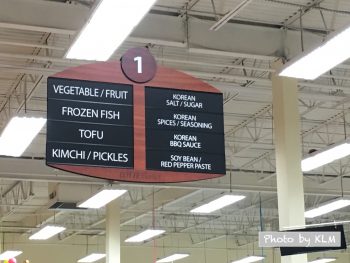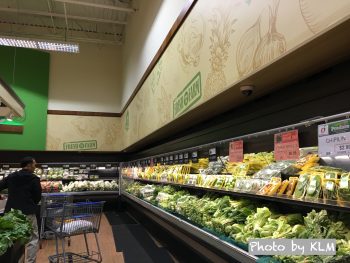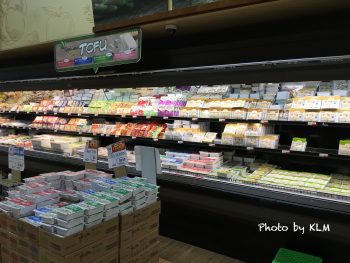Scavenger Hunt at a Korean Supermarket #1 Posted by Kyung-Hwa on Jan 18, 2017 in Korean Language, Vocabulary
Are you interested in making a trip to a Korean supermarket, but you don’t know what to buy?

Going to a Korean supermarket, you might expect an overwhelming experience with unfamiliar arrangement of exotic food items and Korean letters written all over the place. Surprisingly, you will see well-organized isles with English signs throughout the store, and their layouts are close duplicates of American grocery stores, such as Kroger, Safeway, or Trader Joe’s. As long as you don’t mind spending some extra time during your first adventure, you will be able to learn to zip through the store on your next visit.
There are many Korean supermarkets throughout America, and they can be ranged from a small mom and pop style to a large franchise store. If you have big Korean supermarket chains like Lotte Plaza or H Mart near you, taking a trip to these stores can be a great way to not only explore Korean food items but also practice your Korean reading skills.
In this post, I will introduce you to several kinds of Korean 쌀 (rice), common 청과물 (fresh produce) that is used in Korean cooking, 두부 (tofu) for various cooking purposes, and essential Korean 양념 (seasonings) for your pantry. February 1st post will mention 해산물 (seafood),육류 (meat), 라면 (instant noodles), some of popular prepackaged 냉동식품 (frozen foods), and delicatessen section so you can enjoy Korean food conveniently.
쌀 (rice)
Once you walk into the store, you will be amazed to face a big pile of rice bags. Depending on your needs, you can find different kinds of 쌀 (rice): 백미 (white rice), 현미 (brown rice), 반반미 (half brown rice and half brown sweet rice in a bag), and 찹쌀 (sweet rice).

청과물 (fresh produce)
When you pass the 청과물 (fresh produce) section, your eyes will be elated with fresh vegetables and fruits, not only your familiar ones, but also assorted displays of exotic ones. These are some of the items that I like to buy from the 청과물 section: 배추 (napa cabbages), 깻잎 (perilla leaves), 쑥갓 (crown daisy), Korean 배 (pear), 부추 (garlic chives), 콩나물 (bean sprouts), Korean 고구마 (sweet potatoes), 파 ( green onions), 마늘 (garlic), 생강 (ginger).

두부 (tofu)
Can you believe this array of 두부 (Tofu) collection in the picture?
I like to keep 2-3 packages of 두부 in my refrigerator. Just make sure to check the expiration date on the package, 두부 will usually last for several weeks. I like to buy firm 두부 for 국 (soup), 찌개 (stew), or 부침 (frying), and soft 두부 for 샐러드 (salad).
Did you know you can also use firm 두부 to make lasagna?

양념 (seasonings)
If you are interested in cooking Korean food, the following would be essential 양념 (seasonings) that you may like to grab for your pantry.
• 고추장 (hot pepper paste)
Every Korean household will have a tub of 고추장 in their refrigerator. 고추장 is used to add spicy flavor for soups, to dip cooked Korean BBQ, or to mix ingredients in the popular Korean dish 비빔밥.
• 간장 (soy sauce)
간장 is another essential seasoning for Korean dishes. You can use 간장 for dipping your food, making Korean BBQ, or seasoning your soup instead of salt. 간장 especially goes well with 만두 (Korean dumplings).
• 참기름 (sesame seed oil)
참기름 is used to add nutty flavor to many 반찬 (side dishes) in the final stages of cooking, to enhance the taste of 비빔밥, to make Korean birthday soup 미역국 (seaweed soup), or to dip your cooked 삼겹살 (pork belly slices like bacon in America) to add extra flavor.

I hope this article will encourage your visit to a Korean supermarket.
감사합니다! (Thank you!)
***Related Vocabulary***
- 쌀 (rice)
- 백미 (white rice)
- 현미 (brown rice)
- 반반미 (half brown rice and half brown sweet rice in a bag)
- 찹쌀 (sweet rice)
- 청과물 (fresh produce)
- 배추 (napa cabbages)
- 깻잎 (perilla leaves)
- 쑥갓 (crown daisy)
- 배 (pear)
- 부추 (garlic chives)
- 콩나물 (bean sprouts)
- 고구마 (sweet potatoes)
- 파 ( green onions)
- 마늘 (garlic)
- 생강 (ginger)
- 두부 (Tofu)
- 국 (soup)
- 찌개 (stew)
- 부침 (frying)
- 샐러드 (salad)
- 양념 (seasonings)
- 고추장 (hot pepper paste)
- 비빔밥 (popular Korean dish served in a bowl with warm rice, vegetable, and a fried egg)
- 간장 (soy sauce)
- 만두 (Korean dumplings)
- 참기름 (sesame seed oil)
- 미역국 (seaweed soup)
- 삼겹살 (pork belly slices like Bacon in America)

Build vocabulary, practice pronunciation, and more with Transparent Language Online. Available anytime, anywhere, on any device.



